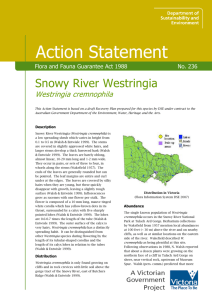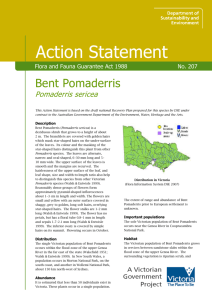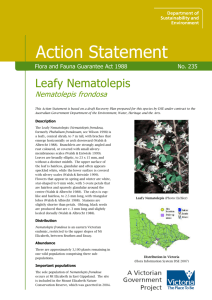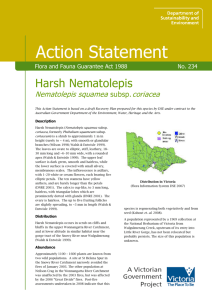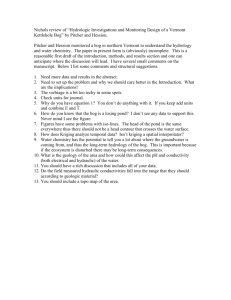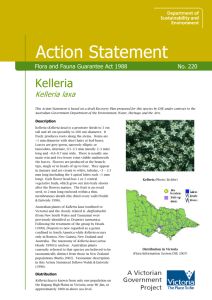(Epilobium brunnescens subsp. beaugleholei) accessible
advertisement
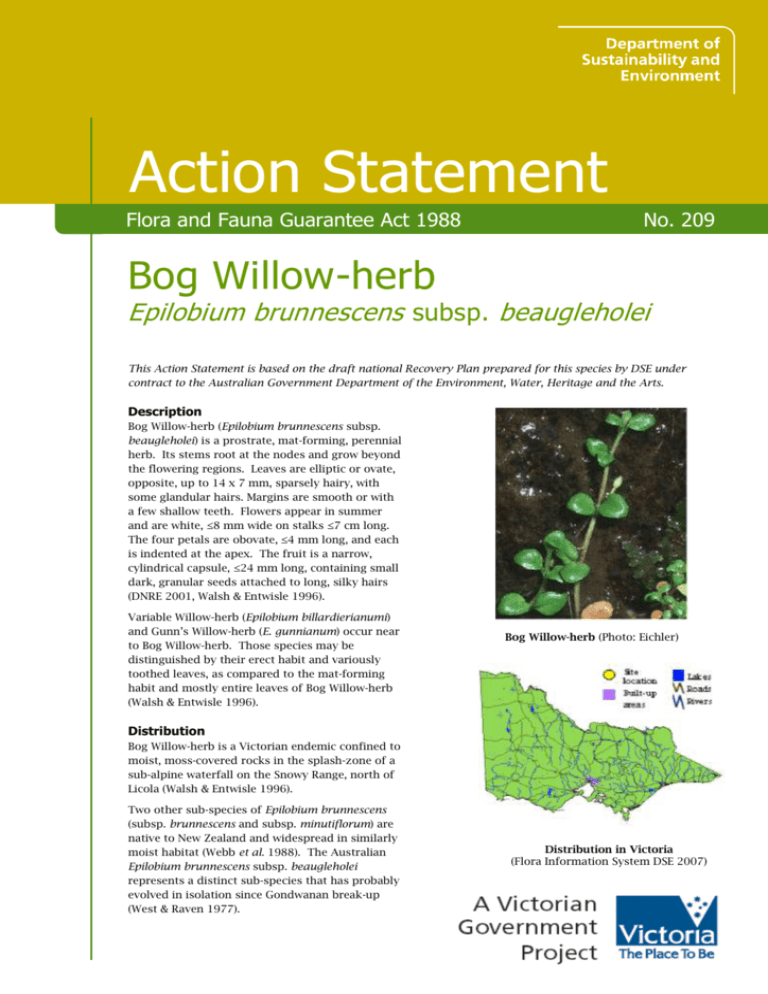
Action Statement Flora and Fauna Guarantee Act 1988 No. 209 Bog Willow-herb Epilobium brunnescens subsp. beaugleholei This Action Statement is based on the draft national Recovery Plan prepared for this species by DSE under contract to the Australian Government Department of the Environment, Water, Heritage and the Arts. Description Bog Willow-herb (Epilobium brunnescens subsp. beaugleholei) is a prostrate, mat-forming, perennial herb. Its stems root at the nodes and grow beyond the flowering regions. Leaves are elliptic or ovate, opposite, up to 14 x 7 mm, sparsely hairy, with some glandular hairs. Margins are smooth or with a few shallow teeth. Flowers appear in summer and are white, ≤8 mm wide on stalks ≤7 cm long. The four petals are obovate, ≤4 mm long, and each is indented at the apex. The fruit is a narrow, cylindrical capsule, ≤24 mm long, containing small dark, granular seeds attached to long, silky hairs (DNRE 2001, Walsh & Entwisle 1996). Variable Willow-herb (Epilobium billardierianumi) and Gunn’s Willow-herb (E. gunnianum) occur near to Bog Willow-herb. Those species may be distinguished by their erect habit and variously toothed leaves, as compared to the mat-forming habit and mostly entire leaves of Bog Willow-herb (Walsh & Entwisle 1996). Bog Willow-herb (Photo: Eichler) Distribution Bog Willow-herb is a Victorian endemic confined to moist, moss-covered rocks in the splash-zone of a sub-alpine waterfall on the Snowy Range, north of Licola (Walsh & Entwisle 1996). Two other sub-species of Epilobium brunnescens (subsp. brunnescens and subsp. minutiflorum) are native to New Zealand and widespread in similarly moist habitat (Webb et al. 1988). The Australian Epilobium brunnescens subsp. beaugleholei represents a distinct sub-species that has probably evolved in isolation since Gondwanan break-up (West & Raven 1977). Distribution in Victoria (Flora Information System DSE 2007) Abundance It is considered ‘endangered’ in Victoria according to DSE’s Advisory List of Rare or Threatened Plants in Victoria – 2005 (DSE 2005). Bog Willow-herb occurs in a single population at Conglomerate Creek Falls occupying approximately 1 m2 cover within 12 m2 habitat. In 1983 at the Conglomerate Creek Falls base site, N. Scarlett recorded 50 plants over 900 m2 of habitat (VROTPOP database). In 2001, J. Eichler recorded 3 patches totalling 1 m2 cover over an area 12 m2. Potentially threatening processes Collection Plants may be targeted by collectors, but are rather inaccessible. Habitat Extreme rarity This species is known from a small population in the wild. Anecdotal information (from J. Eichler) suggests that the population has contracted over the past decade or so. The population of Bog Willow-herb occurs on moist, moss-covered rocks receiving splash from a perennial sub-alpine waterfall on the Snowy Range, north of Licola (Walsh & Entwisle 1996). It occurs with various bryophyte mats and receives little direct sunlight. It is essential that water flow and associated herbage are maintained. Plants permeate the mossy substrate with their long rhizomes; there is little to no soil on the wet rock where plants reside (West and Raven 1977). The altitude is ~1320 above sea level. Climate Change Climate change impacts, including extended drought, may alter the habitat, rendering it unsuitable for the continued existence of the plants. Rock Fall Rock fall may damage the population at the base of Conglomerate Creek Falls. Life history and ecology Little is known of the reproductive biology of Bog Willow-herb. Previous management action Conservation status National conservation status Bog Willow-herb is listed as ‘vulnerable’ under the Commonwealth Environment Protection and Biodiversity Conservation Act 1999. Victorian conservation status Bog Willow-herb has been listed as ‘threatened’ under the Victorian Flora and Fauna Guarantee Act 1988. Post-fire assessment and monitoring of priority populations of threatened flora was conducted after the 2003 wildfire in the Victorian Alps. This included including mapping of populations in conjunction with the fire boundary using existing information, site visits and data collection describing habitat condition, threats, population demography and vital attributes. Conservation objectives, actions and targets Long term objective To ensure that the Bog Willow-herb can survive, flourish and retain its potential for evolutionary development in the wild. Specific objectives, actions and targets The intended management actions listed below are further elaborated in DSE’s Actions for Biodiversity Conservation (ABC) system. Detailed information about the actions and locations, including priorities, is held in this system and will be provided annually to land managers and other authorities. Objective I To increase knowledge of biology, ecology and management requirements Action Targets Responsible 1. Updated records on all state databases (FIS, VROTPop and Herbarium). DSE Acquire baseline population data, including identification of the area and extent of the population; estimates of the number, size and structure of the population; and inference or estimation of population change. Accurate information and maps of all population locations. 2 2. Assess habitat characteristics and/or condition. Accurately survey known habitat, and collect and analyse floristic and environmental information relevant to community ecology and condition. Ecological requirements identified for the completion of essential life history stages, recruitment and dispersal. 3. Conduct survey to locate suitable habitat. Identify and survey potential habitat, using ecological and bioclimatic information that may indicate habitat preference. There are a number of waterfalls at similar altitude in the vicinity. These should be primarily targeted. Predictive model for potential habitat developed and tested. DSE 4. Assess threats. Undertake detailed threat assessment to determine need for action to prevent visitor access. Detailed threat assessment completed. Parks Victoria Undertake research to identify key biological functions. Evaluate current reproductive / regenerative status, longevity, fecundity and recruitment levels by conducting field based experimental trials. Determine seed germination requirements by conducting laboratory and field trials aimed to identify key stimuli and determine stimuli for vegetative regeneration. Regenerative potential quantified for the population. Analyse population trends. Measure population trends and responses against recovery actions by collecting demographic information including recruitment and mortality, timing of life history stages, and morphological data. Collate, analyse and report on census data and compare with management histories. Techniques for monitoring developed and implemented. 5. 6. Objective II DSE Core habitat mapped. Action implemented if required. Stimuli for recruitment/regeneration identified. DSE, Royal Botanic Gardens Management strategies identified to maintain, enhance or restore regenerative processes fundamental to reproduction and survival. Census data collected. DSE, Parks Victoria Population dynamics determined. To secure populations or habitat from potentially incompatible land use or catastrophic loss. Action Targets Responsible 7. Establish cultivated plants ex situ to safeguard from the unforeseen destruction of the wild populations. Successful plant division and growth in glasshouse conditions are described in West and Raven (1977). Development of effective propagation and cultivation techniques. Royal Botanic Gardens Develop, provide input to or implement park, reserve or land management plan. Ensure that information and advice about the recovery of Bog Willow-herb has been provided to Parks Victoria. The Bog Willow-herb and its management needs are addressed in the management plan for the Alpine National Park. 8. Objective III At least 30 mature plants in cultivation. DSE To increase the number of populations or individuals Action Targets Responsible 9. Long-term storage facility identified. DSE, Royal Botanic Gardens Store reproductive material. Establish a seed bank. 10. Determine seed viability. Seed from target populations in storage. Seed viability determined. Royal Botanic Gardens 3 References DNRE (2001) DNRE Flora Information System 2001, Department of Natural Resources and Environment. DSE (2005) Advisory List of Rare or Threatened Plants in Victoria – 2005. Department of Sustainability and Environment, East Melbourne, Victoria. Walsh, N.G. & Entwisle, T.J. (1996) Flora of Victoria Volume 3: Winteraceae to Myrtaceae, Inkata Press, Melbourne. Webb, C. J., Sykes, W.R., & Garnock-Jones, P.J. (1988) Flora of New Zealand Volume IV: Naturalised Pteridophytes, Gymnosperms, Dicotyledons, Botany Division, Department of Scientific and Industrial Research, Christchurch, New Zealand. West, K.R. & Raven, P.H. (1977) Novelties in Australian Epilobium (Onagraceae), New Zealand Journal of Botany, 15: 503-509. This Action Statement has been prepared under section 19 of the Flora and Fauna Guarantee Act 1988 under delegation from Mr Peter Harris, Secretary, Department of Sustainability and Environment, July 2008. Published by the Victorian Government Department of Sustainability and Environment Melbourne, July 2009 © The State of Victoria Department of Sustainability and Environment 2009 This publication is copyright. No part may be reproduced by any process except in accordance with the provisions of the Copyright Act 1968. Authorised by the Victorian Government, 8 Nicholson Street, East Melbourne. ISSN 1448-9902 For more information contact the DSE Customer Service Centre 136 186 Disclaimer This publication may be of assistance to you but the State of Victoria and its employees do not guarantee that the publication is without flaw of any kind or is wholly appropriate for your particular purposes and therefore disclaims all liability for any error, loss or other consequence which may arise from you relying on any information in this publication. Accessibility If you would like to receive this publication in an accessible format, such as large print or audio, please telephone 136 186, 1800 122 969 (TTY), or email customer.service@dse.vic.gov.au This document is also available in PDF format on the Internet at www.dse.vic.gov.au 4
